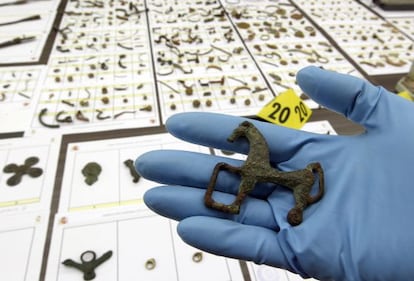Operation Helmet strikes a blow against Spanish tomb raiders
The Civil Guard recovers more than 4,000 archaeological pieces from the Celtiberian period

The Civil Guard have recovered more than 4,000 archaeological pieces pertaining to different cultures, especially those from the peninsular Celtiberian period, as part of Operation Helmet, in the Zaragoza province. The suspect who has been arrested, Ricardo G., has allegedly been plundering various sites in the region for the past 15 to 25 years.
Ricardo is a retiree living in the area of Aranda de Moncayo (Zaragoza), who succeeded in robbing these important historical pieces using metal detectors. One of the sites that was most affected is the five-hectare Celtiberian city of Arátikos.
Most of the recovered pieces were part of warrior burials (ceramics, breastplates, swords, fragments of Celtiberian helmets, shields, brooches, votives, jewelry, etc..), according to the Civil Guard, material which may mostly date between the third and first centuries BC. They stress that the investigations have been very difficult because they had to be carried out in rural areas, where the presence of the agents was easily detectable.
Operation Helmet began last summer when the Office of Environment and Planning, who led the operation, learned of an auction in Germany featuring complete Celtiberian helmets of exceptional value -- Spanish museums only host a few preserved fragments of ancient remains of this sort. These warrior helmets could have left Spain illegally. Researchers estimate that between 13 and 18 Celtiberian helmets have been plundered from the archeological site of Arátikos and subsequently sold abroad.
Prosecutors in Munich asked the Spanish government to reclaim their rightful property. There was no response.
In 2008, when the late German construction tycoon Axel Guttmann´s enormous collection of warrior artifacts went on sale, the Römisch-Germanisches-Zentralmuseum (RGZM) reported that among the objects for sale, some were illegally exported from Spain, including a set of helmets, swords, daggers and spears. Prosecutors in Munich held the pieces and asked the Spanish government to reclaim their rightful property in a three-month period. There was no response.
Then in 2009 and 2010 the items were re-auctioned, a sale that was again denounced RGZM, but there was no reaction from Spain when the helmets were claimed by French museums and Spanish collectors. This past October 25, Christie’s in London sold a new collection with three more helmets, which reached a final price of 90,000 euros. No one prevented this sale.
After initial investigations, the Heritage Unit of the Civil Guard was able to determine that such helmets could have been looted from somewhere in Aragon, although there were also references to other sites in Castilla y León. After locating the the alleged perpetrator of the theft, security forces searched three homes where the artifacts were recovered.
Researchers suspect that the detainee might have plundered not only the site of Aranda de Moncayo, but also Tiermes (part of the Sorian territory of Montejo de Tiermes) as well as nearby Numancia (Garray). Not only had Ricardo G. looted Celtiberian pieces, but also Roman artifacts, including coins. The alleged plunderer, who makes a legitimate living from the harvesting of truffles, has admitted that most of the seized material comes from Aranda de Moncayo.
The allegedly stolen pieces were sold through the black market, most of them via a German collector with a restorer who worked almost exclusively for him. This technician is highly qualified, given the evidence of a “shiny" Celtiberian helmet that was excavated in very poor condition. The investigations have concluded that helmets from Arátikos were auctioned in Germany. Ricardo G. has already been released, after giving evidence to the judge handling the case.
Maria del Rosario Cabrera, the mayor of Aranda de Moncayo, stresses that the Arátikos site lacks the surveillance to prevent looting, and will ask the government of Aragon to take the necessary measures for the site´s protection. "On more than one occasion we have opened graves and found out the hard way, which means the destruction and loss of useful information for archaeologists," the mayor told EL PAÍS. Many local residents routinely find Celtiberian coins, among other pieces, without even digging.







































